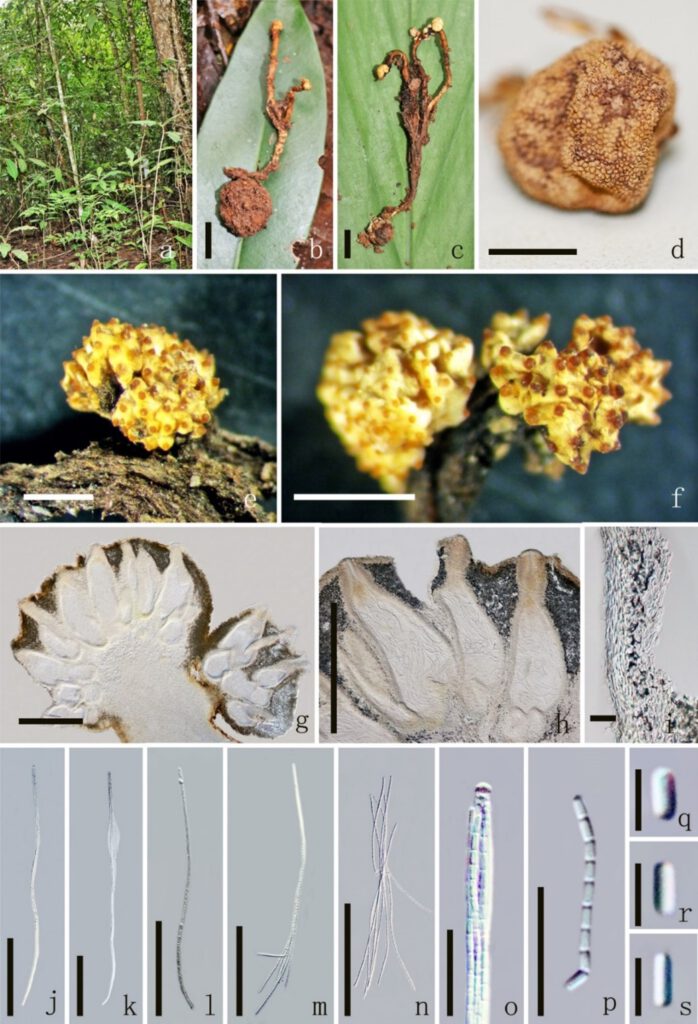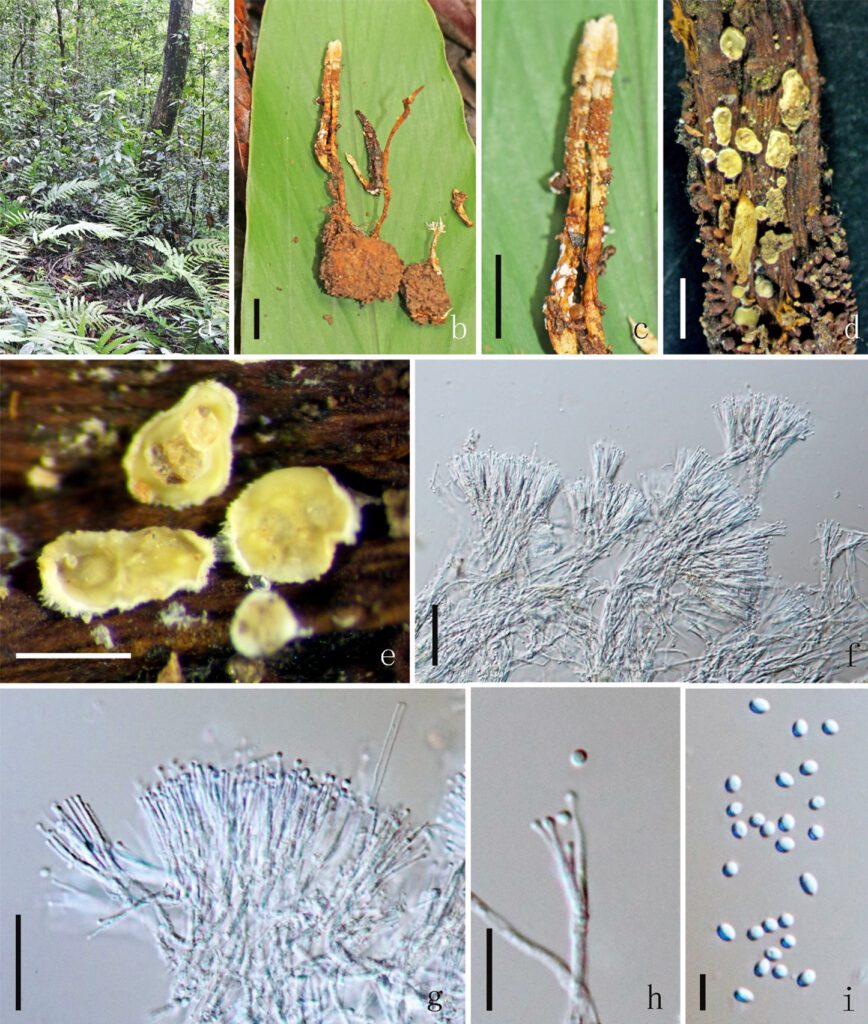Pleurocordyceps parvicapitata Y.P. Xiao, T.C. Wen & K.D. Hyde, sp. nov. Fig. 22, 23.
MycoBank number: MB 559473; Index Fungorum number: IF 559473; Facesoffungi number: FoF 12897;
Etymology: The name refers to the small capitate head.
Holotype: MFLU 21-0270
Parasitic on Elaphomyces sp. (Elaphomycetaceae, Eurotiales) buried in soil. Sexual morph: Host 1.5–2.2 cm diam, globose, brown to dark-brown, rough surface. Stromata 5–15 cm long, 1–5 mm wide., branched, brown to yellow, hard, cylindrical. Stipes 4.5–14 cm long, 0.1–0.45 cm diam., brown to dark brown, branched, with small capitate head. Fertile parts 1–1.5 mm height, 1.5–3 mm diam., yellow to pale yellow, single or capitate, rough, with ostiole. Perithecia 577–751 × 207–281 μm ( = 664 × 244 µm, n = 60), immersed, crowded, ovoid to obpyriform, ostiolate, ostiole lined with periphyses, yellow, thick-walled. Peridium 21–31 µm ( = 26 µm, n = 90) wide, hyaline to yellow, three layers, textura prismatica outer layer, textura angularis middle layer, textura porrecta inner layer. Asci 322–399 × 4.8–6.8 μm ( = 361 × 5.8 µm, n = 90), 8-spored, hyaline, filiform, with a thin apex. Apical cap 1.6–2.6 × 2.8–3.8 μm ( = 2.1 × 3.3 µm, n = 60), thin, hyaline. Ascospores 318–396 × 1.2–1.9 μm ( = 357 × 1.6 µm, n = 90), filiform, hyaline, multiseptated. Secondary ascospores 3.0–4.7 × 1.2–1.8 μm ( = 3.9 × 1.5 µm, n = 90) oblong to cylindrical, one celled, straight, hyaline, smooth-walled.
Parasitic on Perennicordyceps elaphomyceticola (Ophiocordycipitaceae, Hypocreales) or Elaphomyces sp. (Elaphomycetaceae, Eurotiales) from soil. Asexual morph: Hyphomycetous. Synnemata absent on Perennicordyceps elaphomyceticola, repoduced on Elaphomyces sp., 1–1.2 cm long, 1–2 mm wide, stipitate, cylindrical, yellow to white, branched, tapering gradually at the apex, without fertile head. Conidial masses covering the surface of colony on Perennicordyceps elaphomyceticola, white when fresh, light yellow when dry. Conidiophores 21–30 μm ( = 25, n = 60) long, erect, arising from vegetative hyphae, bearing phialides aggregates or clusters, predominantly symmetrically, often additional branches occur which are equal in length form stipe structures, 2–4 phialides. Phialides 11.7–16.3 × 1.1–1.6 μm ( = 14 × 1.4 µm, n = 90), cylindrical at the base, 8–12 μm long, tapering into a long neck, 1–3.5 μm long. Conidia 2.8–3.6 × 2.4–3 μm ( = 3.2 × 2.7 µm, n = 90) globose to subglobose, hyaline, smooth-walled, 1-celled.
Material examined: CHINA, Yunnan Province, Xishuangbanna City, Dadugang County, on Elaphomyces sp. (Elaphomycetaceae, Eurotiales), buried in soil, 11 June 2018, YuanPin Xiao, DG10, DG11a, DG11c (Holotype: MFLU 21-0270); (Paratypes: MFLU 21-0271, MFLU 21-0272). CHINA, Yunnan Province, Xishuangbanna City, Dadugang County, Perennicordyceps elaphomyceticola (Ophiocordycipitaceae, Hypocreales) or Elaphomyces sp. (Elaphomycetaceae, Eurotiales), buried in soil, 11 June 2018, YuanPin Xiao, DG02c, DG02b (MFLU 21-0273, MFLU 21-0274).
Notes: The new species, Pleurocordyceps parvicapitata parasitizing both Perennicordyceps elaphomyceticola (Ophiocordycipitaceae, Hypocreales) and Elaphomyces sp. (Elaphomycetaceae, Eurotiales), is a new taxon in the genus. Three specimens of Pleurocordyceps parvicapitata formed colonies on the surface of Pe. elaphomyceticola and one observed synnemata (Fig. 23). We could not obtain any isolate from the fresh specimen.
In the phylogenetic tree, the new species is sister to Pleurocordyceps lianzhouensis with strong support (Figs 2-3: 100 ML / 1.00 PP; Fig. 16: 96% ML / 1.00 PP). The new species, Pleurocordyceps parvicapitata, differs from other species of Pleurocordyceps in parasitising Elaphomyces sp. (Elaphomycetaceae, Eurotiales) and producing capitate fertile heads, long stipes, and shorter secondary ascospores (Table 8). The asexual morph of Pleurocordyceps parvicapitata is characterized by parasitizing both Perennicordyceps elaphomyceticola and Elaphomyces sp., 2–6 clustered phialides (Table 7). Only one type of phialides has been discovered from a fresh specimen. Furthermore, the new species, Pleurocordyceps parvicapitata, is the first report for taxa parasitic on Perennicordyceps among all family species, likely leading to a deeper understanding of the physiology, evolution, and taxonomy of these groups.

Fig. 22. Pleurocordyceps parvicapitata (Holotype: MFLU 21-0270). a Habitat. b, c Stromata emerging from infected Tuber sp. d Host. e, f Fertile head of stromata. g Cross-section through part of stroma with perithecia. h Perithecia. i Peridium. j–m Asci. n Ascospores. o Apical cap of asci. p Part of ascospores. q–s Secondary spores. Scale Bars: b–d = 1 cm, e, f = 1000 µm, g, h = 500 µm, j–n = 100 µm, i, o, p = 20 µm, q–s = 5 µm.

Fig. 23. Pleurocordyceps parvicapitata (MFLU 21-0273) a Habitat of Pleurocordyceps parvicapitata. B Overview of host. c–e Colony from infected Pleurocordyceps elaphomyceticol. f, g Conidiophores. h Phialides. i Conidia. Scale Bars: b, c = 1 cm, d = 1000 µm, e = 500 µm, f, g = 20 µm, h = 10 µm, i = 5 µm.
